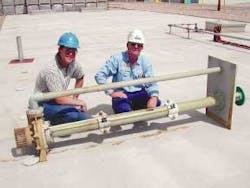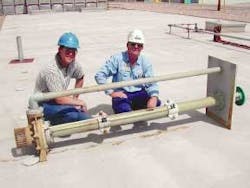In 2002, Roche Colorado, a subsidiary of Hoffman-La Roche, implemented three water conservation measures at its headquarters and production site in Boulder, CO. The projects resulted in annual water savings of 5.4 million gallons and $25,600. The total cost of implementing all three was $23,300 allowing Roche Colorado to achieve a simple payback of just under 11 months.
Roche Colorado is one of four Hoffman-La Roche pharmaceutical research and/or production facilities in the United States. Roche Colorado has been operating in Boulder since 1967 and specializes in the manufacture of bulk intermediates and active ingredients for prescription and over-the-counter medicines. The facility has been recognized for its approach toward energy efficiency and pollution prevention; in 2000 the facility received the Presidential Green Chemistry Challenge award and since 2001 has been certified as a PACE (Partners for a Clean Environment) partner by the city of Boulder.
The Boulder facility is a 30-acre pharmaceutical plant that requires large quantities of water for its production processes. Because the plant's production processes use many chemicals, much of the site's wastewater must be treated before being released into the municipal sewer system. The wastewater treatment system is served by six pumps ranging in size between 5 and 15 horsepower to move the process water through the treatment process.
The Roche plant has a team of employees that have worked on pollution prevention and resource conservation since 1990. Although water conservation had always been a priority for the team, it gained greater urgency in 2002 when the state of Colorado was affected by a severe drought and ordinances were issued requiring individuals and businesses to conserve water.
The team shared ideas with the city of Boulder and surrounding counties to uncover opportunities for water conservation at the plant. After reviewing their water consumption patterns, the team came up with three measures to reduce water consumption. The first measure was to deactivate the fountain in front of the site's headquarters building. Next, the team decided to install a hydrometer to gauge the moisture content in the soil of the company's property. They hoped to link the hydrometer to the site's irrigation system to prevent the sprinklers from activating if the water level in the soil was above a specific threshold.
Lastly, the team decided to test whether the site's wastewater treatment pumps could operate effectively at lower seal flush flow rates. In the process, they found an opportunity to reduce water loss at the pump seal by installing a different seal type.
Before the wastewater treatment pump project was undertaken, the Boulder plant's pumps had a seal flush flow rate of 4 gallons per minute. With the new seal type, the pumps' seal flush flow could be eliminated or replaced with used process water without any adverse effects on the pumps.
The staff upgraded the seal systems on two of the six pumps and started using process water instead of city water for seal flushing on the other four pumps.
Results
The implementation of the water conservation measures yielded important water savings for Roche Colorado. Before the project, the company's annual water consumption was 4 million gallons for irrigation/landscaping and over 10 million gallons for its wastewater treatment processes.
By shutting off the fountain and reducing the irrigation of the corporate campus, the company reduced its water consumption for irrigation and landscaping by 1.9 million gallons per year, which represents an almost 50% decrease in the quantity of water used by those applications.
The modifications made to the six wastewater treatment pumps resulted in a decrease in water consumption of more than 10,000 gallons per day or 3.5 million gallons per year. The three projects resulted in aggregate annual water savings of about 5.4 million gallons and $25,600.
The project did not involve great capital costs, as all that was needed was the hydrometer and the kits for the pumps. The total project costs were $23,300 and with a total annual savings of $25,600, the simple payback was slightly under 11 months.



